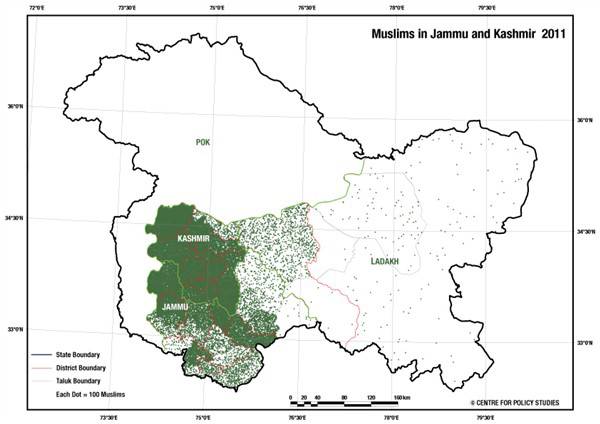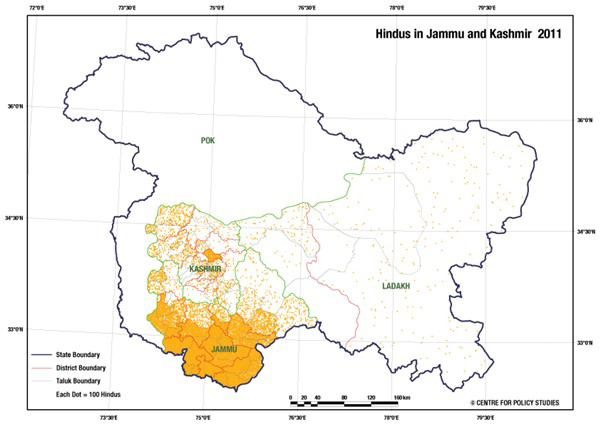
The provisional figures of census in (Pakistan-administered) Azad Jammu & Kashmir and Gilgit-Baltistan indicate that their increase follows the pattern for the population on this side of (India-Administered) Jammu and Kashmir. By way of disclaimer, it is important to note, however, that any comparison is undercut by the fact that the census data from these two regions is from different times. Nevertheless, despite this and other important differences, it is possible to see that growth has been taking place in a similar direction. (This factors in the six percent drop in J&K in the decade from 2001 to 2011.)
According to the figures released by the census organization under the Pakistan Bureau of Statistics, the overall population in AJ&K and GB has increased 44% in about two decades. (The last census was held in 1998). The population was 3.8m in 1998 and has gone up to 5.5m (though the figures are provisional) and could change.
In AJ&K there has been a 36% increase and in GB a steep 71%. The population of AJ&K in 1998 was 29,722501 and it is now 40,45366. The population of GB is 1,492,000 now and it was 873,000 in 1998.
The highest populated district in AJ&K is Muzaffarabad with 650,370 people and the lowest is Neelum district just opposite Keran in Jammu and Kashmir where the population is 191,000. In GB, Gilgit has the highest population of 330,000 and Hunza the lowest of 50,000.
The growth has been steep, much like that of J&K. The census has been conducted here on a more scientific basis. The count is done differently as are the crosschecks. Here we look at religious identities and languages as well.
In Pakistan, census operations are laden with dangers and if reports are to be believed there has been resistance to them in certain parts of GB. Officials cautioned that the figures may go up or down, especially in the case of Diamer where the work could not be completed due to roadblocks and other weather-related problems. However, the data still gives us a fair sense of the growth—though demographically it is one-sided and the entire AJ&K and GB population is said to be Muslim.

When the census in Jammu & Kashmir was conducted in 2011 and final figures were released a few years later, several interesting trends emerged. According to this census J&K has 12.5 million people, an increase from 10.1 million in 2001. There are 6.6 million men and 5.9 million women. In 2001, there were 5.3 men and 4.7 million women.
The growth in this decade was 23% and in the previous decade 29%. So there was a six percent decline in the rate of growth.
Demographically Jammu and Kashmir has been a Muslim-majority state in India with approximately 68% of the state population following Islam as their religion. Hinduism is the second most popular religion (28%). There are much fewer Christians (0.28%), Jains (0.02%), Buddhists (0.9%) and Sikhs (1.87%). Around 0.01% of people tick the ‘Other Religion’ box and approximately 0.16% choose ‘No particular religion’.
The Muslim population in the 2001-2011 decade increased by 1.7 million, while the number of Hindus grew by 561,000. According to the religious population data of Census 2011, there was addition of 2.3m souls since 2001, taking the population to 12.5m in the Himalayan state.
What was interesting in the 2011 census was that the myth about Ladakh region being “Buddhist-dominated” was busted. According to the census, the cold desert region has a population of 274,289 people with 127,296 Muslims contributing to 46% of the population and 108,761 people are Buddhists (39%). Twelve percent of people (33,223) are Hindus. Leh has more Buddhists while Kargil has more Muslims. Leh with a population of 133,487 has 88,635 Buddhists (66) while 19,057 Muslims contribute to 14% and 22,882 Hindus make up 17% of the district. However, Kargil with the population of 140,802 has 108,239 Muslims (76%), 20,126 Buddhists (14%) and 10,341 Hindus (7%).
Similarly out of ten districts in Jammu (which is generally referred to as Hindu-majority) six are Muslim majority. Jammu, Kathua, Udhampur and Samba have more Hindus. But even Reasi, which is thought to be a Hindu-dominated district has a Muslim-majority population (156,275 or 49% against 153,896 Hindus forming 48% of the total 314,667 people in the district). Similarly, the Pir Panjal region (Rajouri-Poonch) and Chenab Valley (Doda-Ramban-Kishtwar) region are also Muslim-dominated by a significant margin. Of the 1,119,251 people in the Pir Panjal region 834,158 are Muslims (74%) while 254,484 Hindus make up 22% of the total populace. Muslims also contribute to 59% of Chenab Valley with a population of 554,355 against 362,578 Hindus (39%) of the total of 924,345 people in the region.
In Kashmir region, which has a total population of 6,888,475 people, Muslims form 96% of the population (6,640,957) while there are 2.45% Hindus (168,813).
It is worthwhile to mention that the population of Jammu and Kashmir was a little over 4m in 1947 and it has grown manifold in 70 years. Muslims constituted around 77% of the population in 1947 and this figure has remained more or less the stable. The final figures in the case of AJ&K and GB will further help understand the changes.
The writer is a senior journalist based in Srinagar (Kashmir) and can be reached at shujaat7867@gmail.com Attachments
According to the figures released by the census organization under the Pakistan Bureau of Statistics, the overall population in AJ&K and GB has increased 44% in about two decades. (The last census was held in 1998). The population was 3.8m in 1998 and has gone up to 5.5m (though the figures are provisional) and could change.
In AJ&K there has been a 36% increase and in GB a steep 71%. The population of AJ&K in 1998 was 29,722501 and it is now 40,45366. The population of GB is 1,492,000 now and it was 873,000 in 1998.
According to the figures released by the census organization under the Pakistan Bureau of Statistics, the overall population in AJ&K and GB has increased 44% in about two decades. (The last census was held in 1998)
The highest populated district in AJ&K is Muzaffarabad with 650,370 people and the lowest is Neelum district just opposite Keran in Jammu and Kashmir where the population is 191,000. In GB, Gilgit has the highest population of 330,000 and Hunza the lowest of 50,000.
The growth has been steep, much like that of J&K. The census has been conducted here on a more scientific basis. The count is done differently as are the crosschecks. Here we look at religious identities and languages as well.
In Pakistan, census operations are laden with dangers and if reports are to be believed there has been resistance to them in certain parts of GB. Officials cautioned that the figures may go up or down, especially in the case of Diamer where the work could not be completed due to roadblocks and other weather-related problems. However, the data still gives us a fair sense of the growth—though demographically it is one-sided and the entire AJ&K and GB population is said to be Muslim.

When the census in Jammu & Kashmir was conducted in 2011 and final figures were released a few years later, several interesting trends emerged. According to this census J&K has 12.5 million people, an increase from 10.1 million in 2001. There are 6.6 million men and 5.9 million women. In 2001, there were 5.3 men and 4.7 million women.
The growth in this decade was 23% and in the previous decade 29%. So there was a six percent decline in the rate of growth.
Demographically Jammu and Kashmir has been a Muslim-majority state in India with approximately 68% of the state population following Islam as their religion. Hinduism is the second most popular religion (28%). There are much fewer Christians (0.28%), Jains (0.02%), Buddhists (0.9%) and Sikhs (1.87%). Around 0.01% of people tick the ‘Other Religion’ box and approximately 0.16% choose ‘No particular religion’.
The Muslim population in the 2001-2011 decade increased by 1.7 million, while the number of Hindus grew by 561,000. According to the religious population data of Census 2011, there was addition of 2.3m souls since 2001, taking the population to 12.5m in the Himalayan state.
When the census in Jammu & Kashmir was conducted in 2011, several interesting trends emerged. According to this census J&K has 12.5 million people, an increase from 10.1 million in 2001. Muslims constituted around 77% of the population in 1947 and this figure has remained more or less the stable
What was interesting in the 2011 census was that the myth about Ladakh region being “Buddhist-dominated” was busted. According to the census, the cold desert region has a population of 274,289 people with 127,296 Muslims contributing to 46% of the population and 108,761 people are Buddhists (39%). Twelve percent of people (33,223) are Hindus. Leh has more Buddhists while Kargil has more Muslims. Leh with a population of 133,487 has 88,635 Buddhists (66) while 19,057 Muslims contribute to 14% and 22,882 Hindus make up 17% of the district. However, Kargil with the population of 140,802 has 108,239 Muslims (76%), 20,126 Buddhists (14%) and 10,341 Hindus (7%).
Similarly out of ten districts in Jammu (which is generally referred to as Hindu-majority) six are Muslim majority. Jammu, Kathua, Udhampur and Samba have more Hindus. But even Reasi, which is thought to be a Hindu-dominated district has a Muslim-majority population (156,275 or 49% against 153,896 Hindus forming 48% of the total 314,667 people in the district). Similarly, the Pir Panjal region (Rajouri-Poonch) and Chenab Valley (Doda-Ramban-Kishtwar) region are also Muslim-dominated by a significant margin. Of the 1,119,251 people in the Pir Panjal region 834,158 are Muslims (74%) while 254,484 Hindus make up 22% of the total populace. Muslims also contribute to 59% of Chenab Valley with a population of 554,355 against 362,578 Hindus (39%) of the total of 924,345 people in the region.
In Kashmir region, which has a total population of 6,888,475 people, Muslims form 96% of the population (6,640,957) while there are 2.45% Hindus (168,813).
It is worthwhile to mention that the population of Jammu and Kashmir was a little over 4m in 1947 and it has grown manifold in 70 years. Muslims constituted around 77% of the population in 1947 and this figure has remained more or less the stable. The final figures in the case of AJ&K and GB will further help understand the changes.
The writer is a senior journalist based in Srinagar (Kashmir) and can be reached at shujaat7867@gmail.com Attachments

